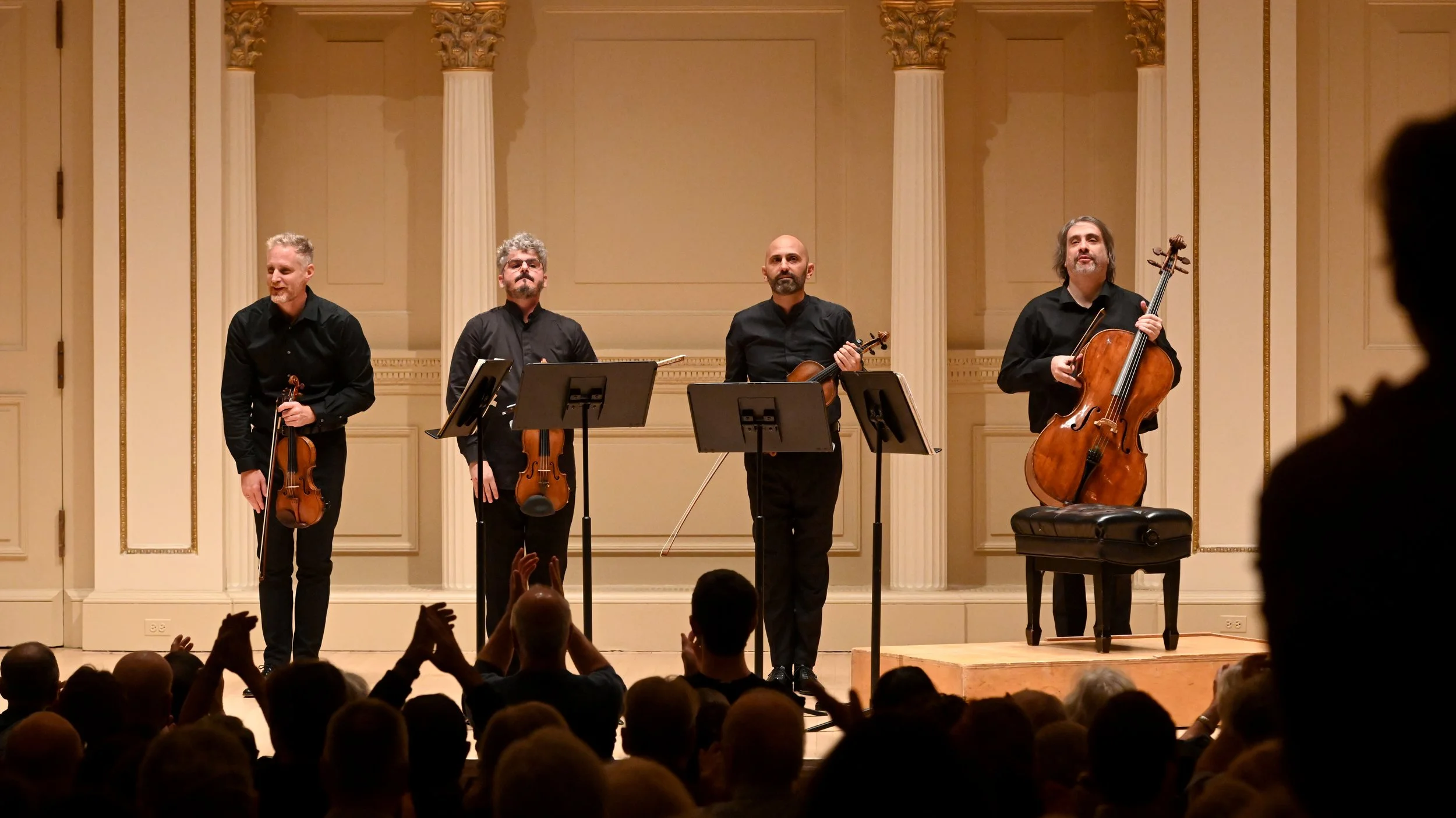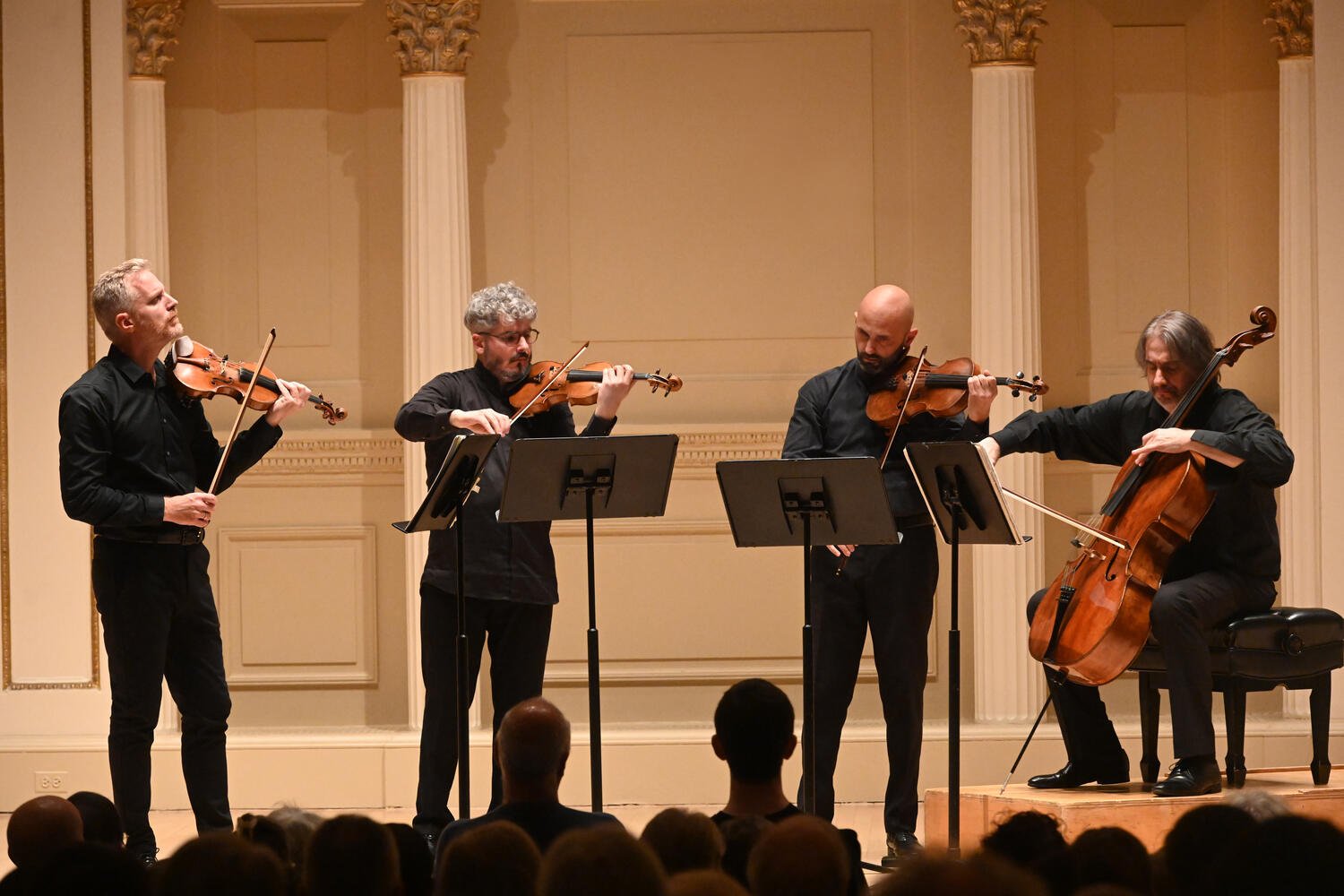REVIEW: Quartetto di Cremona at Weill Recital Hall
Above photo by Pete Checchia.
October 26, 2023
Hailing from Cremona, Italy, once home to legendary violin maker Antonio Stradivarius, the award-winning Quartetto di Cremona has been honing their craft as an ensemble for nearly two decades. They finally made their Carnegie Hall debut in an impressive concert of significant repertoire in the perfect venue, Weill Recital Hall.
The evening’s program was an inspired progression from light to dark. They began with the purely enchanting, innocent, and free: Hugo Wolf’s Italian Serenade. Maurice Ravel’s String Quartet in F Major, which gazes through a gem-like, crystalline clock-work followed. Then, looking inward, Ludwig van Beethoven’s String Quartet in A Minor, Op. 132 probed soulful depths through struggle and prayer. Finally, with an encore from J. S. Bach’s The Art of Fugue, we arrived at music reduced to its absolute essence — raw and theoretical.
This thrilling string quartet plays with a well-sculpted, unified interpretation; they have studied the ins and outs of each phrase, as well as the vertical texture. They work as a team, while allowing each individual immense freedom to bring his full self to each moment.
Hugo Wolf’s Italian Serenade, a single-movement charmer from 1887, opens at a driving tempo. First violinist, Cristiano Gualco, tosses off a long unspooling melody with a windswept, pastoral character, over a scampering accompaniment. On his spectacular 1640 Amati — made in Cremona — Gualco immediately defines the character of the piece, bringing a distinctly casual air to the decorative tune. The piece quickly becomes more contrapuntal, with second violin, viola, and cello taking turns introducing themselves, chiming in with little melodic questions and answers.
Together they infuse the piece with effervescence. Wolf’s harmonic language (closer in vocabulary to Richard Strauss than Schumann or Brahms) is full of harmonic surprises and clever chromaticism, but the Quartet simply allows it to speak. In their hands, the Serenade almost conjures a bird soaring over the Mediterranean landscape, taking in the colors and aromas.
Photo by Pete Checchia.
Ravel’s Quartet, from 1902-3, also trades in effervescence, and the Cremona whips it up like a Champagne cocktail they’ve poured a few times. Settling nicely into the Recital Hall’s intimate environs, the foursome dove into Ravel’s tautly constructed jewel box with an insouciance, an almost carefree approach, that belies the subtle complexity of the composition.
The Quartetto’s interpretation finds a visceral thrust aiming toward the piece’s architectural peaks, toward the sweet-and-sour poignancies in Ravel’s harmonic poetry. Especially beautiful is the seamless handing off of the musical line from one player to another, as in the exquisite build in the first movement’s development section.
The way they allow each player to stir the pot, when given the melody, gives the ensemble a jostling camaraderie, and makes the performance feel fresh and spontaneous. The magic is that each has unique qualities. Second violin, Paolo Andreoli, technically hand-in-hand and equal to Gualco, has a malleable timbre, melting into the texture, or rising to the top with a plush singing tone.
Simone Gramaglia’s color palette on the viola is especially beguiling — raspy and brooding, or tender and sweet, depending on the music’s needs. Cellist Giovanni Scaglione’s rhythmic infallibility forms a sturdy foundation, such as in the scherzo-like second movement’s snappy pizzicato opening. And he watches over the proceedings with ears like antennae, actively listening and making space for the music.
The mood and spirit turned more serious in the program’s second half, but the Quartetto still avoided ponderousness in a bracing, urgent rendition of Beethoven’s Op. 132, the first to be composed of his profound, prophetic “late quartets.” The first movement’s alarming changes of tempo, and the first violin’s outbursts of expression, suggested the Romantic era bubbling beneath the surface of Classicism, nearing its boiling point. Here again, the Quartetto di Cremona, without sacrificing rhythmic detail, focuses on the big picture, keeping the long line driving forward. The second movement, a melancholy sort of scherzo, was heady and breezy, like an apparition, thanks to exceptional dynamic control, ever so rarely rising above a pianissimo.
Photo by Pete Checchia.
The group had wisely been pacing the evening to allow for the heart of the piece, Beethoven’s "Holy song of thanksgiving of a convalescent to the Deity, in the Lydian mode.” Their tempo was not uncomfortably slow (as it has occasionally been performed), but the journey of healing and renewal was well-earned. The fourth movement’s rustic and rowdy march was suitably gritty, and the finale brimmed with a sense of adventure and arrival.
They brought a similar knack for transcending technical demands and getting to the core of the music in the encore of Bach. During ovations, they acknowledged the influence of members of the recently retired Emerson Quartet in the audience. It felt like a passing of the torch.
***
Quartetto di Cremona continues their current tour with appearances in Philadelphia, PA and New Haven, CT. They next appear in NYC Fri. Mar 8, 2024 at Chamber Music of Lincoln Center.







